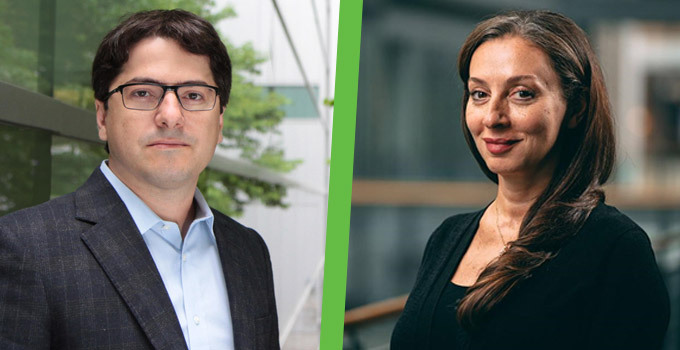A blood test to diagnose and classify tumours could be revolutionary and practice-changing for patients and clinicians alike. In many cases, a simple blood sample could take the place of more invasive surgery to obtain tissue samples – resulting in better treatment planning and less anxiety for patients.

In an OICR-supported study recently published in Nature Medicine, researchers have shown that a simple but sensitive blood test can accurately diagnose and classify different types of brain tumours. With further research and development, the test could serve as a less-invasive method to detect, diagnose and classify the severity of brain tumours.
The study was also presented virtually on June 22 at the Opening Plenary Session of the American Association for Cancer Research Annual Meeting 2020: Turning Science into Lifesaving Care.
A major challenge in treating brain cancers is the accurate diagnosis of different types of brain cancers, and tumours ranging from low grade – which can look like normal brain tissue under a microscope – to aggressive tumours. Cancer grades are used to determine prognosis, and assist in treatment planning.
Current methods to diagnose and subtype brain cancer rely on invasive surgical techniques to obtain tissue samples. Surgery comes with high risks and can cause anxiety for patients.
The ability to diagnose and classify brain tumours without the need for a tissue sample is revolutionary and practice-changing. In some cases, surgery may not even be necessary.
“If we had a better and more reliable way to diagnose and subtype tumours, we could transform patient care,” says Dr. Gelareh Zadeh, Medical Director of University Health Network’s (UHN) Krembil Brain Institute, Head of Surgical Oncology and Senior Scientist at the Princess Margaret Cancer Centre and co-senior author in the study. “It would have a tremendous impact on how we treat these cancers, and in how we plan our treatments.”
“If we had a better and more reliable way to diagnose and subtype tumours, we could transform patient care.”
Dr. Gelareh Zadeh
Zadeh worked with OICR-supported scientist Dr. Daniel De Carvalho at Princess Margaret Cancer Centre, who is a world leader in the field of cancer epigenetics applied to early detection, classification and novel therapeutic interventions.
De Carvalho specializes in a type of epigenetic modification called DNA methylation which plays an important role in how genes are turned on and off in cells. In cancer cells, DNA methylation patterns are disrupted, leading to unregulated cancer growth.
De Carvalho has previously developed a DNA methylation-based liquid biopsy approach, called cfMeDIP-seq, to profile hundreds of thousands of these epigenetic alterations in ctDNA, tumour DNA molecules that circulate in the blood.
Working together, Zadeh and De Carvalho applied this approach to intercranial brain tumours. The collaborating researchers analyzed tumour tissue and ctDNA from more than 200 patients, then developed a computer algorithm to classify the brain tumour type based solely on the circulating tumour DNA.
Prior to this, it was not thought possible to detect any brain cancers with a blood test because of the impermeable blood-brain barrier, says Zadeh. This barrier exists between the brain’s blood vessels and its tissue, protecting the brain from any toxins in the blood.
“But because this test is so sensitive in picking up even small amounts of highly specific tumour-derived signals in the blood, we now have a new, noninvasive way of detecting and discriminating between common brain tumours – something which was long thought impossible. This really is a tour de force,” explains Zadeh.
“The possibility to map epigenetic modifications genome-wide, combined with powerful computational approaches, has brought us to this tipping point.”
Dr. Daniel De Carvalho
De Carvalho, who is also a Canada Research Chair in Cancer Epigenetics and Associate Professor at University of Toronto, adds that the field of identifying tumour-specific alterations in ctDNA with new, more sensitive tests in various body fluids – such as blood and urine – is now at a turning point because advanced technologies can detect and analyze even the smallest traces of cancer-specific molecular signatures from the vast quantities of circulating non-tumour DNA fragments.
“The possibility to map epigenetic modifications genome-wide, combined with powerful computational approaches, has brought us to this tipping point,” says De Carvalho. “Molecular characterization of tumours by profiling epigenetic alterations in addition to genetic mutations gives us a more comprehensive understanding of the altered features of a tumour, and opens the possibilities for more specific, sensitive, and tumour agnostic tests.”
In an accompanying paper, also recently published in Nature Medicine, De Carvalho and his collaborators from the Dana-Farber Cancer Institute at Harvard University show their approach can accurately identify kidney cancer from circulating cell-free DNA obtained either from blood plasma or from urine.
De Carvalho is currently working with Dr. Philip Awadalla, OICR Senior Investigator, to apply his cfMeDIP-seq approach to samples from the Canadian Partnership for Tomorrow’s Health (CanPath).
“With OICR’s support, we’ve been able to apply cfMeDIP to new cancer types and to blood samples from individuals who haven’t yet developed the disease,” says De Carvalho. “This means we could ultimately use these methods to detect cancers much earlier, while bring less invasive testing and diagnostic methods to more patients with the disease.”
This post has been adapted from a UHN news release.
